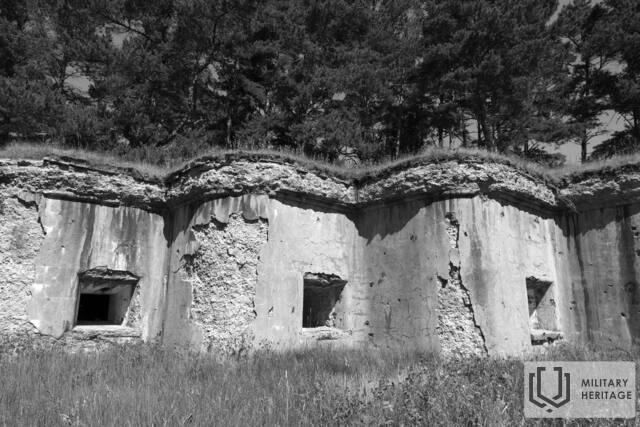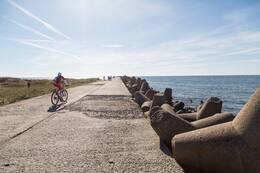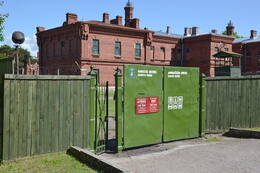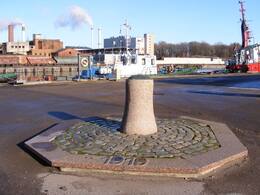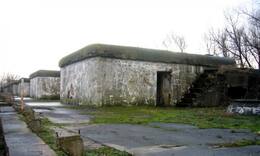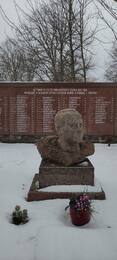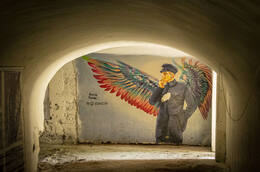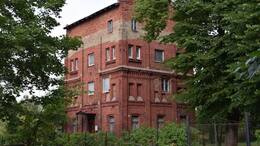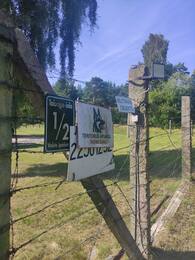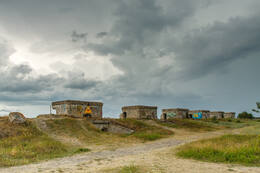Liepojos jūrų tvirtovė I WW1
Tvirtovė buvo pastatyta XIX a. pabaigoje – XX a. pradžioje, siekiant apsaugoti Liepojos karinio jūrų laivyno bazę galimo priešo atakos atveju.
Įtvirtinimų sistema, kuriai priklausė, pavyzdžiui, Redanas ir Šiaurinis fortas, supo visą miestą. Iš dalies į jūrą nuplauti Šiauriniai fortai gali būti pavojingi lankytis.
Daugiau informacijos šaltinių
Liepojos istorijos vingiai: Liepojos tvirtovė (liepajasvesture.blogspot.com)
Susijusios vietos
Šiaurinis molas ir 3-ioji baterija Karostoje
Ilgiausias molas Latvijoje – Šiaurinis molas – buvo pastatytas XIX a. pabaigoje kaip labai svarbi Liepojos jūros tvirtovės ir karinio uosto dalis. Molo ilgis – 1800 metrų, plotis – 7,35 metro.
Šiaurinis molas yra vienas pirmųjų imperatoriaus Aleksandro III uosto statinių, pastatytas 1890–1892 m., prieš kasant Karostos kanalą. Kartu su Šiauriniu molu, Pietiniu molu ir Pietiniu molu molas sudarė Liepojos užkampį.
Liepojos tvirtovės 3-ioji baterija buvo įsikūrusi šalia Karostos šiaurinio molo ir buvo planuojama, kad ji bus didžiausia ginkluotės atžvilgiu. Buvo pastatytos platformos keturiems 6 colių (152 mm) 1892 m. modelio „Canet“ sistemos pabūklams, penkiems 11 colių (280 mm) 1887 m. modelio pabūklams ir dviem 57 mm „Nordenfeld“ prieštankiniams pabūklams, taip pat 18 9 colių (229 mm) pabūklų ir minosvaidžių.
Šiandien 3-iąją bateriją labiausiai veikia vyraujanti pietų-šiaurės jūros srovė, kuri už Šiaurinio molo sukuria sūkurį, dėl kurio išplaunami patrankų platformos pamatai.
Šiaurinis molas saugo Liepojos uosto teritoriją nuo šiaurės vakarų vėjų. Tai mėgstama vieta Liepojos gyventojams ir lankytojams stebėti saulėlydžius, žvejoti ir stebėti jūrą įvairiomis oro sąlygomis. Ypač įspūdinga audrų metu.
Šiaurinėje prieplaukoje yra daug vietos automobiliams pastatyti. Taip pat yra tualetai ir kavinė su unikaliu vaizdu į jūrą.
Laivo „Saratov“ prieplauka Liepojoje
„Saratov“ prieplauka yra Liepojoje, Senojoje uoste, 59, netoli laivų prieplaukos.
Pastatytas 1888 m. Kopenhagoje laivų statyklos „Buvmeistar & Wain“ pavadinimu „Leopold II“, 1911 m. jį įsigijo akcinė bendrovė „Russian North-West Shipping“ ir pervadino į „Saratov“, o laivo kapitonu tapo latvis Aleksandras Remessas.
1915 m. gegužę, kai Liepoją okupavo vokiečių kariuomenė, laivas „Saratovas“ uoste buvo apgadintas.
1919 m. sausio 10 d. garlaivį „Saratov“ perėmė Latvijos laikinoji vyriausybė. Nuo 1919 m. balandžio iki liepos mėn., po „balandžio 16 d. perversmo“, K. Ulmanio vadovaujama laikinoji vyriausybė buvo „Saratov“ laive ir buvo priversta slėptis sąjungininkų laivyno globoje.
1919 m. liepos 8 d., laikinajai K. Ulmanio vyriausybei perdavus Rygą, garlaiviai buvo naudojami susisiekimui tarp Rygos, Ventspilio ir Liepojos.
Pagal 1920 m. rugpjūčio 11 d. Latvijos ir Sovietų Rusijos taikos sutarties sąlygas garlaivis „Saratovas“ turėjo būti grąžintas Sovietų pusei. 1923 m. sausio 2 d. garlaivis buvo perduotas Sovietų Rusijos atstovui. 1923 m. sausio 15 d. garlaivis „Saratovas“ sudužo prie Akmenrago krantų.
1936 m. Latvijos jūrų departamentas pardavė nuolaužas įmonei, kuri jas sutvarkė ir perdavė Liepojos audinių fabrikui.
Liepojos tvirtovės baterija Nr.6
6-oji baterija, kuri šiandien yra geriausiai išsilaikęs įtvirtinimų statinys, buvo suplanuota Liepojos tvirtovės pakrantei į pietus nuo Prekybos kanalo apsaugoti. Baterijoje turėjo būti keturios 6 colių (152 mm) 1892 m. modelio „Canet“ sistemos patrankos, aštuonios 11 colių (280 mm) 1887 m. modelio patrankos, devyni įvairaus kalibro minosvaidžiai ir du 57 mm „Nordenfeld“ prieštankiniai pabūklai. Pirmojo pasaulinio karo pradžioje, tvirtovei jau esant išardytai, 6-ojoje baterijoje vis dar buvo ginkluotė, panaudota 1915 m. balandžio mėn., kai Vokietijos karinis jūrų laivynas bandė išsilaipinti prie Pietinio molo.
XX a. trečiojo dešimtmečio pradžioje baterijos vietoje pradėtas statyti Olimpijos stadionas, kurį galima pamatyti ir šiandien. Pietiniame baterijos gale iškastas įtvirtinimų griovys šiandien yra įtrauktas į Liepojos pajūrio parką.
Paminklas žuvusiems žvejams, jūreiviams ir JAV lakūnams
250 metrų į pietvakarius nuo 6-osios baterijos yra Žvejų ir jūreivių paminklas su lenta, skirta JAV karinio jūrų laivyno žvalgybiniam lėktuvui PB4Y-2 Privateer, numuštam prie Liepojos 1950 m. balandžio 8 d. Lėktuvas, pravarde „Turbulentinis vėžlys“, priklausė 26-ajai patrulių eskadrilei ir pakilo iš Vysbadeno aerodromo balandžio 8 d. ankstyvą rytą ir per Kopenhagą išvyko į stebėjimo ir galbūt radijo žvalgybos misiją. Pagal įsakymą lėktuvas negalėjo priartėti prie Kuršo pakrantės arčiau nei 20 jūrmylių, tačiau dėl nežinomos priežasties jis įskrido į SSRS pačios nustatytą 12 jūrmylių zoną. Du sovietų 30-ojo gvardijos naikintuvų pulko La-11 perėmė ir numušė neginkluotą žvalgybinį lėktuvą. Numušto lėktuvo 10 narių įgulos likimas nėra tiksliai žinomas; yra prieštaringų žinių, kad visi pilotai žuvo arba kad kai kurie pilotai išgyveno ir pateko į karo belaisvių stovyklas.
Įgula:
AT1 Frank L. Beckman
AL3 Joseph J. Bourassa
ENS Tommy L. Burgess
1 m. po Kr. Joseph H. Danens
Leitenantas Johnas H. Fette'as
CT3 Edwardas J. Purcellas
LTJG Robertas D. Reynoldsas
AN Joseph N. Rinnier
Leitenantas Howardas W. Seeschafas
1 m. po Kr. Jackas W. Thomasas
Liepojos tvirtovės pietinis fortas ir paminklas N. Dedajevui, Raudonosios armijos 67-osios šaulių divizijos vadui
Liepojos tvirtovės Pietinis fortas yra pietvakarinėje Liepojos dalyje, tarp Klaipėdos gatvės ir paplūdimio.
Buvo planuojama pastatyti fortą imperatoriaus Aleksandro III uosto apsaugai iš pietų, du kilometrus nuo pietinės miesto sienos. Fortas turėjo būti tarp Liepojos ežero ir jūros, į vakarus nuo Perkūno upės žiočių, o gelžbetoninius įtvirtinimus sutvirtinti grioviu. Nors įtvirtinimai buvo beveik visiškai baigti, ginkluotė dar nebuvo dislokuota. Pastatyti rūsiai buvo naudojami kaip sandėliai tiek Pirmojo, tiek Antrojo pasaulinio karo metu. XX a. 3-ajame ir 4-ajame dešimtmečiuose įtvirtinimų teritorijoje buvo įsikūrusios įvairios gamyklos. Skirtingai nuo Viduriniojo forto ir Ravelino, Pietinis fortas niekada nedalyvavo kare, nes visuose karuose užpuolikai buvo apgulę Liepojos ežero rytinę pakrantę ir bandė įsiveržti į Liepoją tarp Tosmarės ir Liepojos ežerų.
Į šiaurę nuo Pietinio forto yra didžiausios Liepojos kapinės – Centrinės. Pietinėje kapinių dalyje yra Raudonosios armijos kapinės, kuriose perlaidoti Liepojos apylinkėse žuvę sovietų kariai, tarp jų ir 67-osios šaulių divizijos vadas generolas majoras Nikolajus Dedajevas, vadovavęs Liepojos gynybai 1941 m. birželį.
Redanas, Karosta
Redanas, arba Redanos fortas, yra Karostoje, lapkričio 14 d. gatvėje, apie 1,5 km nuo Šiaurinių fortų, gamtos rezervate „Tosmare“.
Istoriškai redanai buvo įtvirtinimų elementai, kur ilgesnės tvirtovės sienų atkarpos buvo dalijamos į trumpesnes dalis, įrengiant V formos pozicijas, nukreiptas į priešą, taip geriau apsaugant įtvirtinimų sieną. Karosto redanas yra XIX a. pabaigos Liepojos jūros tvirtovė, išsikišusi link Tosmarės ežero. Tvirtovei praradus savo, kaip tvirtovės, vaidmenį, aplink ją esantys įtvirtinimai ir fortai buvo iš dalies susprogdinti ir paversti nebenaudotinais. Tačiau Redanas išliko beveik nepaliestas.
1919 m. lapkritį, po nesėkmės Rygoje, Pavelo-Bermonto Avalovo pajėgos pradėjo intensyvų Liepojos puolimą. Mūšis vyko ir Redane, kur kovojo 80 Liepojos karinio uosto komendantūros kareivių, vadovaujamų vado leitenanto Radzinio. Lapkričio 14 d. per greitą puolimą bermontininkams pavyko užimti Redaną. Po to sekė Latvijos kariuomenės kontrataka ir Redanas buvo atsiimtas.
Birželio, liepos ir rugpjūčio mėnesiais kiekvieną dieną nuo 11.00 iki 17.00 val. Redane jūsų lauks patyręs gidas, pasiruošęs papasakoti daugiau apie Liepojos tvirtovę ir istorinius įvykius Karostoje.
Karvelių pašto jūrų stotis Karostoje
Buvusi karinio jūrų laivyno balandžių stotis Nr. 2 – iš tikrųjų veisimo stotis – yra Karostoje, Pulkveža Brieža gatvėje 6. Ji buvo pastatyta 1899–1900 m. ir buvo skirta apgyvendinti apie 450 pašto balandžių – sparnuotųjų karių. Vėlesniais metais pastatas buvo pertvarkytas į butus, todėl išliko tik raudonų plytų pastato korpusas. Kita pašto balandžių stotis, Nr. 1, kuri neišliko, buvo skirta 750 sausumos karių naudojimui ir buvo įsikūrusi Atmodas bulvaro šiauriniame gale.
Pašto balandžiai buvo paprastas, greitas ir patikimas būdas užtikrinti ryšį tarp kranto ir laivų jūroje. Nors radijo telegrafas, kaip moderni ryšio priemonė, tuo metu jau buvo plačiai naudojamas, balandžių naudojimas buvo laikomas saugesniu – priešas galėjo perimti pranešimą tik perimdamas patį pašto balandį. Pašto balandžiai judėjo vidutiniu 60 km per valandą greičiu, tačiau palankiomis vėjo sąlygomis jie galėjo judėti iki 100 km per valandą greičiu. Balandžius reikėjo specialiai paruošti ir apmokyti, todėl su jais elgtis reikėjo atsargiai ir kantrybės. Pašto balandžio ryšys veikė per paukščių gebėjimą grįžti į savo namų narvelį. Kai paukštis buvo perkeltas į kitą vietą – balandžių stotį, paleidimo ir paleidimo punktą – ir paleistas su pranešimų kapsule, mažasis pasiuntinys grįždavo į savo namų narvelį. Siekiant užtikrinti ryšį tarp dviejų balandžių stočių, kiekvienoje reikėjo laikyti tam tikrą skaičių paukščių, kurie buvo užaugę korespondento ryšio, arba pašto balandžių, stotyje. Kiekvienais metais balandžiai dalyvaudavo įvairiuose manevruose ir varžybose. Taip pat po Latvijos nepriklausomybės, nuo 1920 iki 1940 m., Liepojoje buvo įsikūrusi Latvijos armijos Kuršo divizijos pašto balandžių stotis, kuri galėjo susisiekti tiek su Ryga, tiek su Daugpiliu. Tarpukariu į Latvijos teritoriją taip pat atklydo pašto balandžiai iš Vokietijos, Lenkijos, Lietuvos, Suomijos ir Estijos. Balandžiai iš Latvijos staiga buvo aptikti ir kaimyninėse šalyse.
Pastatas per daugelį metų buvo kelis kartus perstatytas ir dabar yra gyvenamasis pastatas. Tačiau išskirtinė pastato forma, pastatyta iš raudonų plytų, būdingų seniesiems Karostos pastatams, vis dar aiškiai matoma iš išorės.
Liepojos pakrantės artilerijos baterija Nr.2
Tarp daugelio Liepojos jūrų muziejaus eksponatų, Liepojos pakrantės artilerijos baterija Nr. 2 iki šiol yra paslaptingiausia vieta Liepojoje. Antrojoje baterijoje visada buvo įrengti įvairių valstybių karių šaudmenų sandėliai.
Liepojos tvirtovės 2-oji baterija buvo pastatyta toliau nuo pakrantės ir buvo apsaugota aukšta įtvirtinimų siena. Baterija buvo ginkluota 16 11 colių (280 mm) minosvaidžių, pagamintų 1877 m. modelio. Išardžius tvirtovę, čia buvo įrengti šaudmenų sandėliai. Dėl sprogimo pavojaus teritorija 130 metų buvo uždaryta visuomenei, saugoma, tačiau dabar čia įrengta paroda apie 1-ojo Kuršo divizijos štabo veiklą 1919–1940 m., taip pat eksponuojami 1-ojo Liepojos pėstininkų pulko, 2-ojo Ventspilio pėstininkų pulko ir Kuršo artilerijos pulko fotografiniai įrodymai.
Liepojos šiaurinis fortas ir 1-oji baterija Karostoje
Šiauriniai fortai yra geriausiai žinoma ir vizualiai įspūdingiausia Liepojos tvirtovės dalis. Juos XIX a. pabaigoje pastatė Rusijos caro armija, o istorinis jų pavadinimas – 1-oji tvirtovės baterija.
1908 m. lapkritį, praėjus mažiau nei 10 metų po Liepojos tvirtovės pastatymo, ji nustojo veikti, nes jos statyba buvo pripažinta strategine klaida. Dalis patrankų buvo išardytos ir išvežtos į Kauno tvirtovę Lietuvoje, o kitos – išlydytos. Fortifikaciniai statiniai buvo du kartus susprogdinti, siekiant sunaikinti įtvirtinimus. Iki šių dienų išlikusios detalės yra sprogimų metu nevisiškai sunaikintos artilerijos baterijos ir požeminiai statiniai. Kaip ir Karosta, Šiauriniai fortai sovietų okupacijos metu buvo uždara karinė teritorija. Šiaurinių fortų lankytojai turėtų būti labai atsargūs. Kaip ir kitose Latvijos pakrantės vietose, status Baltijos jūros krantas Karostoje yra pavojingas dėl galimų pakrantės nuošliaužų. Todėl po fortų griuvėsiais vaikščioti draudžiama.
Šiaurinėje tvirtovės dalyje buvo įsikūrusi viena iš keturių pakrantės gynybos baterijų – 1-oji baterija. Baterijoje turėjo būti šešios 6 colių (152 mm) 1892 m. modelio „Canet“ sistemos patrankos, šešios 11 colių (280 mm) 1887 m. modelio patrankos ir dvi 57 mm „Nordenfeld“ priešlaivinės patrankos. Tik „Canet“ sistemos patrankos turėjo pakankamai ilgą šaudymo nuotolį, kad atlaikytų galimą Vokietijos karinio jūrų laivyno apšaudymą. Taigi, likviduojant tvirtovę, ginkluotė buvo sumontuota tik iš dalies.
Susijusi istorija
Sovietų aviacijos antskrydžiai Liepojos priemiestyje 1944 m. spalio ir gruodžio mėn
Antrojo pasaulinio karo pabaigoje Vokietijos pajėgos Kurše galėjo sėkmingai gintis septynis mėnesius, nes Vokietijos karinis jūrų laivynas išlaikė kovinį pajėgumą iki Antrojo pasaulinio karo pabaigos ir aprūpino armijų grupę „Šiaurė“, o vėliau ir armijų grupę „Kuržemė“. Pagrindinis uostas buvo Liepoja, per kurią buvo pristatoma ir gabenama 80 % visų krovinių. Taigi Liepoja tapo svarbiu sovietų Baltijos karinio jūrų laivyno ir tolimojo nuotolio aviacijos taikiniu.
Generolo majoro N. Dedajevo sužalojimas Liepojos tvirtovėje, Viduso forte
1941 m. birželį sėkmingas vokiečių armijos puolimas pasiekė Liepoją, kai Liepoją puolė Vokietijos šarvuočių 291-oji pėstininkų divizija. Kai 1941 m. birželį prasidėjo karo veiksmai tarp nacistinės Vokietijos ir Sovietų Sąjungos, sovietų armijos Liepojos garnizoną sudarė Liepojos jūrų bazės ir Raudonosios armijos kariai. Šių mūšių metu generolas majoras N. Dedajevas buvo mirtinai sužeistas.
Redano mūšis 1919 m. lapkritį
Donatas Pudulis buvo Liepojos karinio uosto komendantūros seržantas, 1919 m. lapkričio 14 d. gavęs Ardėnų mūšio ordiną už drąsą ir narsą, kai, priešui užpuolus Redano fortą, perėmė komendanto kuopos vadovavimą iš mirtinai sužeisto vado leitenanto Roberto Radzinio ir greito kontratakavimo metu išvijo priešą iš forto, paimdamas 8 belaisvius ir 2 veikiančius kulkosvaidžius. Įdomus jo gyvenimas iki Liepojos mūšio. Būdamas 16 metų, 1911 m. jis savanoriškai įstojo į Sibiro šaulių pulką. 1914 m. jis dalyvavo mūšiuose su vokiečių armija Varšuvoje, Lodzėje ir kitur Lenkijos fronte, vėliau – mūšiuose su Austrijos armija. 1915 m. jis per Vladivostoką išplaukė į Prancūziją kaip Rusijos ekspedicinio korpuso dalis ir 4 mėnesius kovojo Verdune. 1917 m. pradžioje jis įstojo į Latvijos šaulių pulkus, o 1919 m. balandžio 7 d. – į Latvijos ginkluotąsias pajėgas Liepojoje.
Sparnuoti kareiviai
XX amžiaus pradžioje pašto balandžiai buvo plačiai naudojama bendravimo priemonė.
Karosta – vokiško He-111 nusileidimo vieta Liepojos paplūdimyje 1939 m.
1939 m. rugsėjo 11 d. vokiečių bombonešis „Henkel He-111“, reidavęs Lenkijos miestus, naktį nukrypo nuo kurso ir avariniu būdu nusileido Liepojos paplūdimyje. Šis įvykis aprašytas Liepojos gyventojo ir Kuržemės divizijos ryšių kuopos karininko Vilio Zobenso atsiminimuose. Nusileidimo vieta gamtoje nepažymėta. Apytikslės koordinatės yra N 56.59368° E 21.01598° – paplūdimyje netoli Šiaurinių fortų.
Vilio Narkevičiaus kovinės veiklos 1919 m. lapkričio 6 d. aprašymas
Būrio vado, leitenanto Juliaus Rosenthalio Vilio Narkevičiaus, kovinės veiklos aprašymas, 1921 m. lapkričio 3 d.
Apdovanojimo skyrimo šarvuoto traukinio vadui A. Klestrovui priežastys
Sėkmingai atremdamas priešo ataką, ginkluoto traukinio vadas A. Klestrovas žuvo, o pulkininkas Dankeris išdavė apdovanojimo pagrindą.




